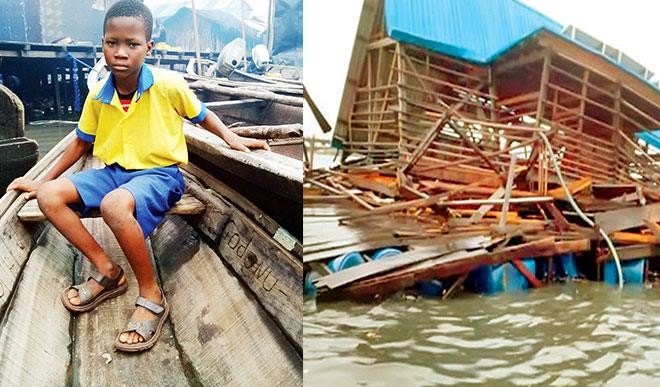
Barely four years after the idea of a floating school was conceivedand birthed on arguably Nigeria’s biggest slum, Makoko area of Lagos State, the story has changed today. The floating school, which spontaneously became a global symbol of purposeful developmental effort, suddenly fell flat on June 7, 2016. Daily Trust has however dug in, unearthing claims and controversies.
Thirteen-year-old David Awonjogbe aspires to be a lawyer. A primary-six pupil of Nwanya Nursery and Primary School, Makoko, Lagos, David said he is defying all odds to get his dreamrealized. And like every other pupil of Nwanya School, who trudges through the community’s murky water on daily basis to seek education within a choked and plank-induced storey building designated as their school, David no doubt has a daunting task ahead of him.
An intervention project that could have given David and hundreds of his other school mates a conducive atmosphere for learning was conceived in 2012 by development partners including the United Nations Development Programme (UNDP), Heinrich Böll Foundation, the Federal Ministry of Environment and Africa Adaptation Programme, birthing what was widely celebrated as the first known floating school in this part of the world.
The Makoko Floating School, built of timber struts and floating on a platform made of 250 plastic barrels, was described in the Daily Trust on Saturday publication of June 21, 2014 as an “unusual school that maintains from afar, a picture of a sailing ship. Except that this wooden ship is not moving an inch.” Despite being stripped of the usual smooth pathway, well-grazed lawn, beautiful flowers and well-paved-dormitories that have become features of a normal school setting, Makoko floating school used to maintain an unusual attraction that never seized to captivate attention.
Yet beyond the ingenuity of its conception and torrents of accoladesit has garnered from home and abroad, the existence of Makoko Floating School was one that has been fraught with anxiety – one that David and tens of his colleagues who once inhabited it nursed throughout the period of their stay.
“I love the floating school. But we didn’t stay for too long in it. We were taken away from it in second term. My friends and I were always afraid any time there was a windstorm because the building will be shaking violently,” David said.
That nasty torment of windstorm described by David was said to have become a recurrent experience and it ended up becoming the sole-factor, community members identified as the cause of the floating school’scollapse. “There was no way the floating school could have survived the turbulence that came with the windstorm that day,” Emanuel Dosu, a fisherman whose house is situated close to the site of the floating school said. “I witnessed its collapse and there was nothing anyone could have done at the time to rescue the situation. It was by God’s grace that it didn’t end up killing someone.”
Dosu was not the only living witness to the collapse of the floating school. Noah Shemide, the initiator and head teacher, Nwanya Nursery and Primary School said it was a brutal scene that has since left him with nostalgic recollections. “I felt very bad that the school collapsed because this was one project that has attracted so much attention to Makoko community,” Shemide, 28, who said he has been running the school in the last eight years, said with utter dejection.
“On the day theschool collapsed, I was standing in front of the main school while the strong wind was on and I could see how the floating school was moving back and forth. I was seriously worried because even after we moved the kids out in March 2016, I know of some old women within the community who often seek refuge at its basement to mend their fishing nets.
“And so when the windstorm was on, I was simply praying that none of those women would be there. Sadly, after a few moment of observing it, I saw it crashing down and that was it. I was just thankful that the students were not there and none of the old women was there. No one would have survived such powerful crash.”
Shemide was, however, quick to note that the regret he and the school community shared about the floating school was not just about its eventual collapse, but its failure to serve its much-hyped purposes of providing classroom spaces for pupils of Nwanya Nursery and Primary School.
“While it was still standing, it was only able to serve us for few months and that was between October 2015 and March 2016 when we had to evacuate our pupils because of the persistent danger it posed any time the windstorm got fierce. To kick-start its usage, we moved primary five and six pupils to the place.
“But I recollect that before the building collapsed, some parents of our pupils who have observed the absurdities of the floating school had issued a stern warning that they won’t take it lightly with me in the event that the building, which they saw as an impending danger, collapses on their kids. And I thank God that I hearkened onto their advices and moved the kids out three months before it collapsed. If I had not, none of them would have escaped and I’m sure that I would currently be in jail,” the Headteacher said.
Shemide lamented that since the return of his Primary Five and Six pupils, there has been space constrain at the main school which currently harbours 259 pupils. He said currently, he had to convert a part of the school library and his own office to a classroom which now provides space for the kids to use for now.
At the moment, there’s a disagreement between major stakeholders in what should be the way forward in the aftermath of the floating school collapse. Whereas Shemide and the Parents’ Forum are against the re-introduction of the school because of the perceived danger they felt it poses totheir kids, the architect who designed the building, Kunle Adeyemi, and a number of community leaders are pushing for a re-introduction of a stronger floating school.
Asked on what he thought should be the way out, Shemide said: “what we need now is a better school building constructed in the same manner we construct some of our residential houses here which are not too talland are constructed with strong wood. We need to expand. And that is my dream now. There is a place behind the main school, where we can expand to and it will be in the same style with our residential houses here which can last up to 30 years. To build the new school, I hope to meet with parents to fine-tune that. Also, this is because we would need help from all concerned stakeholders including government.”
However, Shemide’s sibling who’s a prominent Baale (Community leader) in Makoko, Chief Emmanuel Shemide, said it is the desire of the community to have the floating school restored. This, according to the Baale is because “when the school was still standing it served both our children and other community members who often converge at itsbasement to merge their fishing nets.”
Chief Shemide said what the community desired was a stronger floating school. But when reminded that some parents are spoiling for war if the school is re-introduced and their children asked to attend classes there, the Baale said their fear was quite understandable as there is no one who will be willing to lose his orher kids in a gruesome manner. He nevertheless said if a better and stronger floating school is erected, the people might be persuaded tostill return there.
Other community members, who spoke to Daily Trust on Saturday, faulted the location of the collapsed school. They opined that if the building had been erected within the community where other houses would serve as its shield, the eventual crash could have been avoided. They were quick to observe that the site of the building made it easy prey to windstorm as there were no shields for a building of its size.
Efforts to get the architect, Adeyemi of NLE studio, to comment on the development proved abortive. After some pressure, he promised to respond when he is less busy. He has not done so as at the time of filing this report.
The challenges notwithstanding, Shemide said he would not be looking back in the struggle to liberate his riverine community with affordable education for all. He said if not for anything, the success statistics remains a delight.
“Currently, we have 259 students in the school. Also, a total of 59pupils have so far graduated since we started the journey in 2008. As we speak, some of our former pupils are in Senior Secondary School One (SS1) and Junior Secondary School Three (JS3).
“We are praying and hoping that in the next three years, we should havesome of our past pupils in universities.We couldn’t have nursed a better ambition. Imagine if we had notkick-started the process when we did, I can’t imagine what would havebecome the current state of those students who are now in SeniorSecondary classes. They are our future. The Makokofuture that cannot be pulled down by windstorm,” Shemide said.

 Join Daily Trust WhatsApp Community For Quick Access To News and Happenings Around You.
Join Daily Trust WhatsApp Community For Quick Access To News and Happenings Around You.


